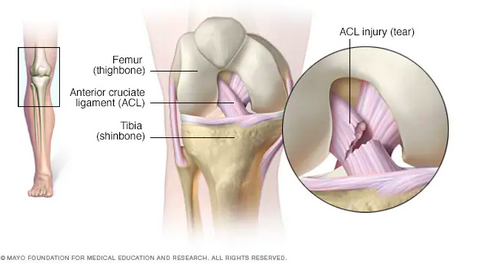OUWB student is co-author of published orthopedic research

Photo courtesy of the Mayo Clinic
A model of an injury to the ACL.
Madeleine DeClercq, second-year medical student at the Oakland University William Beaumont School of Medicine (OUWB), is a co-author of a study recently published in The American Journal of Sports Medicine.
DeClercq worked on the study as an undergraduate student at the University of Michigan (UofM).
The study investigated hypertrophy (enlargement) of the anterior cruciate ligament (ACL) in response to mechanical loading. The ACL is a ligament that stabilizes the knee joint and helps connects the femur to the tibia. It is often injured in sports that put stress on the knee. A smaller ACL is associated with a greater risk of injuries.
This study hits close to home for DeClercq, who tore her ACL while completing as a ski racer in high school.
“I tore my ACL ski racing so that’s kind of how I got interested in surgery and sports medicine,” DeClercq said.
Completing a gap year doing research for The Steadman Clinic, a world-renowned orthopedic clinic with various locations in Colorado, DeClercq expressed interest in orthopedic surgery as her future specialty as a physician. She is also keeping her mind open to other specialties and experiences as she continues her journey through medical school.
“It fits pretty well with who I am but anything could happen,” DeClercq said.
A total of 52 figure skaters and springboard divers in their early twenties from local organizations were recruited for the study. Researchers chose these elite athletes as subjects because figure skaters always jump/land on the same leg and springboard divers use the same leg to drive into the board during their hurdle. Both types of athletes habitually load one leg more than the other. These athletes also served as a unique study population because their contralateral leg could be considered the control group.
To be selected for the study, athletes were required — among other specifications — to have participated in their sport before, during, and after puberty. This was a requirement because previous studies in animal models have suggested that exercise during pubertal growth periods results in a hypertrophied ACL with improved mechanical properties. A goal of this study was to contribute to these findings in humans. Magnetic resonance imaging (MRI) and strength testing were used to investigate differences.
Researchers in this study found that athletes experienced ACL hypertrophy in the leg habitually loaded more than the other before, during, and after puberty. These findings demonstrate that the ACL can be “trained” to become larger, thus becoming less prone to injuries.
When asked what the main takeaway from this study is, DeClercq said, “I would say that there’s potential for the ACL to be trained and that gives implications for injury prevention.
For more information regarding the study, a link to the full paper can be found here.





